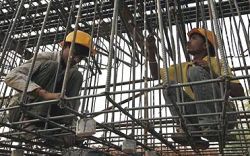 For a little more than a third of Indian companies, the money they make from operations does not even cover the interest payments of their debt obligations.
For a little more than a third of Indian companies, the money they make from operations does not even cover the interest payments of their debt obligations.
A Credit Suisse Securities report titled ‘Corporate financial health tracker’ said 36 per cent of the companies they’d examined had an interest coverage (IC) ratio of less than one, meaning their interest payment obligation is greater than what they earn from operations.
The report examined data for 3,700 listed non-financial companies, whose total debt was around $400 billion.
“The share of debt with chronically stressed corporates declined to 26 per cent (in the fourth quarter of 2013-14) versus 31 per cent in the third quarter (3Q14).
However, the share of debt with companies having an IC less than one for eight consecutive quarters increased to 35 per cent versus 29 per cent in 3Q14 and the aggregate interest cover worsened marginally to 2.5x,” said the June 13 report, authored by research analysts Ashish Gupta, Prashant Kumar and Kush Shah.
Deepak Jasani, head of retail research at HDFC Securities, said this had been on a downward trend in the previous quarters.
“Mid-scale or small-scale companies have faced a problem due to slowdown in the past few quarters. But if the economy improves, as it is expected to, these companies might see better days.
Of the 36 per cent, 15-20 per cent might not be able to improve on their situation; some others might be able to take advantage of the improved sentiment,” he said.
Analysts suggest equity issuances (to retire debt) could help.
These might pick up in as little as two quarters, according to Sandeep Singal, co-head of institutional equities at Emkay Global Financial Services.
 “The whole outlook has changed and there is greater investor appetite. One could see Rs 20,000-25,000 crore in fund raising is in the offing, with some of it being used to retire debt. Chemicals and building materials are among the (likely) sectors,” he said.
“The whole outlook has changed and there is greater investor appetite. One could see Rs 20,000-25,000 crore in fund raising is in the offing, with some of it being used to retire debt. Chemicals and building materials are among the (likely) sectors,” he said.
Lalit Nambiar, fund manager at UTI Asset Management Company, also said companies were likely to see fresh equity infusions. “Most of the affected companies are infrastructure ones, also facing cash flow problems. They can get out of it if projects are implemented. Alternatively, they can get in additional equity or the banks that have lent them the money could look to convert their positions into equity,” he said.
If banks did so, said Nambiar, this would indirectly help other businesses as well. “This frees banks to lend elsewhere and the additional liquidity will help the business cycle.”
As much as 28 per cent of the total debt is with loss-making companies.
“While most large corporates have been highlighting plans for de-leveraging, progress on this front has been relatively slow (also for some of the large announced deals, the cash inflow is in the first quarter of FY15).
For the largest 50 borrowers with IC less than one, debt levels went up by seven per cent in FY14 even as Ebitda (operating earnings) dropped by nine per cent. Consequently, debt/Ebitda multiples have deteriorated to 14.6x from 12.3x,” added the report.
Equity issuances are only likely to take off for companies in sectors in vogue, felt Jasani. “Older sectors which are not likely beneficiaries of the reform, such as automobile ancillaries, machine tool companies or small-sized metal companies would find it hard to raise equity even at current levels,” he said.




.jpg)






